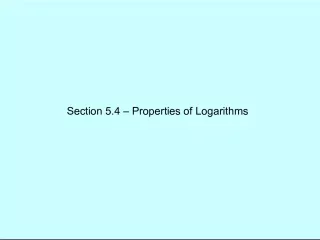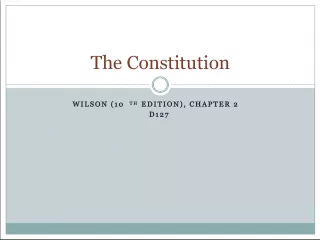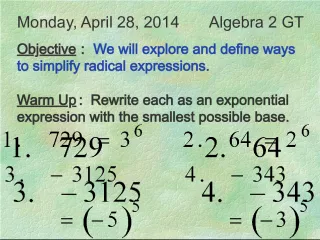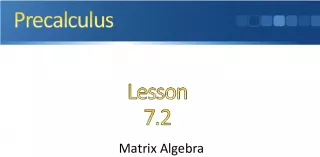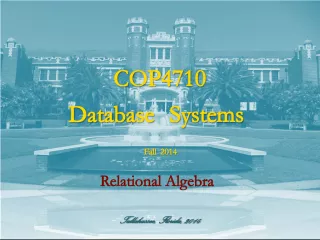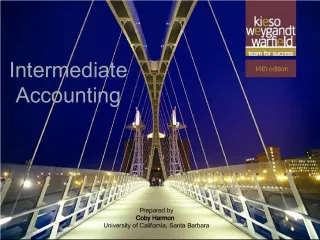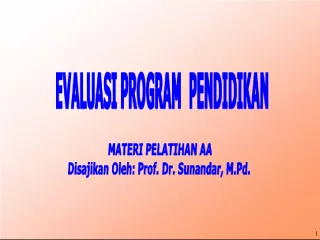College Algebra 10th Edition - Evaluating Logarithms
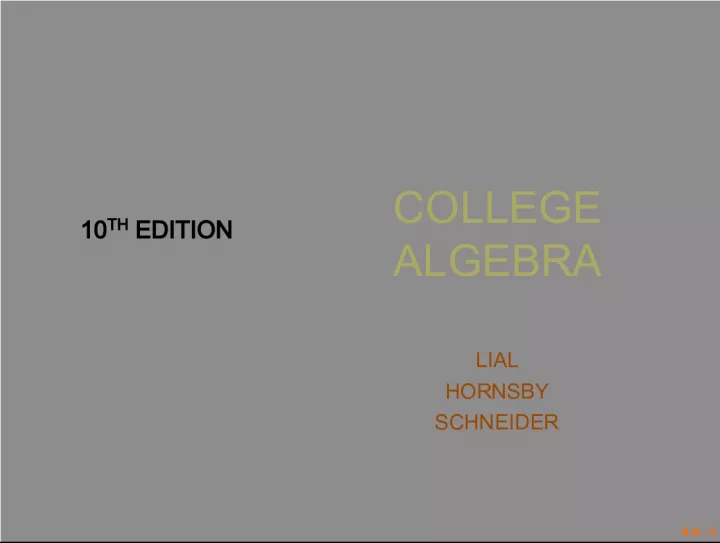

Learn about logarithms and their common applications in modeling, with special emphasis on evaluation and change of base theorem. The 10th edition of the College Algebra book by Lial, Hornsby, and Schneider offers comprehensive coverage of this fundamental topic of algebra.
- Uploaded on | 7 Views
-
 marcelo
marcelo
About College Algebra 10th Edition - Evaluating Logarithms
PowerPoint presentation about 'College Algebra 10th Edition - Evaluating Logarithms'. This presentation describes the topic on Learn about logarithms and their common applications in modeling, with special emphasis on evaluation and change of base theorem. The 10th edition of the College Algebra book by Lial, Hornsby, and Schneider offers comprehensive coverage of this fundamental topic of algebra.. The key topics included in this slideshow are Logarithms, Change of Base Theorem, Common Logarithms, Natural Logarithms, Modeling,. Download this presentation absolutely free.
Presentation Transcript
1. 4.4 - 1 10 TH EDITION LIAL HORNSBY SCHNEIDER COLLEGE ALGEBRA
2. 4.4 - 2 4.4 - 2 4.4 Evaluating Logarithms and the Change- of-Base Theorem Common Logarithms Applications and Modeling with Common Logarithms Natural Logarithms Applications and Modeling with Natural Logarithms Logarithms with Other Bases
3. 4.4 - 3 4.4 - 3 Common Logarithm For all positive numbers x, log x = log 10 x.
4. 4.4 - 4 4.4 - 4 Common Logarithms A calculator with a log key can be used to find the base ten logarithm of any positive number. Consult your owners manual for the keystrokes needed to find common logarithms.
5. 4.4 - 5 4.4 - 5 Note Base a, a > 1, logarithms of numbers between 0 and 1 are always negative, as suggested by the graphs in Section 4.3.
6. 4.4 - 6 4.4 - 6 Applications and Modeling In chemistry, the pH of a solution is defined as where [H 3 O + ] is the hydronium ion concentration in moles per liter. The pH value is a measure of the acidity or alkalinity of a solution. Pure water has pH 7.0, substances with pH values greater than 7.0 are alkaline, and substances with pH values less than 7.0 are acidic. It is customary to round pH values to the nearest tenth.
7. 4.4 - 7 4.4 - 7 Example 1 FINDING pH Solution a. Find the pH of a solution with [H 3 O + ] = 2.5 10 -4 . Substitute Product property log 10 -4 = 4 Distributive property
8. 4.4 - 8 4.4 - 8 Example 1 FINDING pH Solution b. Substitute Multiply by 1. Write in exponential form. Evaluate 10 -7.1 with a calculator. Find the hydronium ion concentration of a solution with pH = 7.1.
9. 4.4 - 9 4.4 - 9 Note In the fourth line of the solution in Example 1(a), we use the equality symbol, =, rather than the approximate equality symbol, , when replacing log 2.5 with .3979. This is often done for convenience, despite the fact that most logarithms used in applications are indeed approximations.
10. 4.4 - 10 4.4 - 10 Example 2 USING pH IN AN APPLICATION Wetlands are classified as bogs, fens, marshes, and swamps. These classifications are based on pH values. A pH value between 6.0 and 7.5, such as that of Summerby Swamp in Michigans Hiawatha National Forest, indicates that the wetland is a rich fen. When the pH is between 4.0 and 6.0, it is a poor fen, and if the pH falls to 3.0 or less, the wetland is a bog. Suppose that the hydronium ion concentration of a sample of water from a wetland is 6.3 10 5 . How would this wetland be classified?
11. 4.4 - 11 4.4 - 11 Example 2 USING pH IN AN APPLICATION Solution Definition of pH Substitute Product property Distributive property Since the pH is between 4.0 and 6.0, the wetland is a poor fen.
12. 4.4 - 12 4.4 - 12 Example 3 MEASURING THE LOUDNESS OF SOUND The loudness of sounds is measured in a unit called a decibel. To measure with this unit, we first assign an intensity of I 0 to a very faint sound, called the threshold sound. If a particular sound has intensity I, then the decibel rating of this louder sound is Find the decibel rating of a sound with intensity 10,000 I 0 .
13. 4.4 - 13 4.4 - 13 Example 3 MEASURING THE LOUDNESS OF SOUND Solution Let I = 10,000 I 0 . log 10,000 = log 10 4 = 4 The sound has a decibel rating of 40.
14. 4.4 - 14 4.4 - 14 Natural Logarithms In Section 4.2, we introduced the irrational number e . In most practical applications of logarithms, e is used as base. Logarithms with base e are called natural logarithms, since they occur in the life sciences and economics in natural situations that involve growth and decay. The base e logarithm of x is written ln x (read el-en x ). The expression ln x represents the exponent to which e must be raised in order to obtain x.
15. 4.4 - 15 4.4 - 15 Natural Logarithm For all positive numbers x,
16. 4.4 - 16 4.4 - 16 Example 4 MEASURING THE AGE OF ROCKS Geologists sometimes measure the age of rocks by using atomic clocks. By measuring the amounts of potassium 40 and argon 40 in a rock, the age t of the specimen in years is found with the formula where A and K are the numbers of atoms of argon 40 and potassium 40, respectively , in the specimen.
17. 4.4 - 17 4.4 - 17 Example 4 MEASURING THE AGE OF ROCKS Solution a. How old is a rock in which A = 0 and K > 0? If A = 0, and the equation becomes The rock is new (0 yr old).
18. 4.4 - 18 4.4 - 18 b. The ratio for a sample of granite from New Hampshire is .212. How old is the sample? Example 4 MEASURING THE AGE OF ROCKS Solution Since , we have The granite is about 1.85 billion yr old.
19. 4.4 - 19 4.4 - 19 Example 5 MODELING GLOBAL TEMPERATURE INCREASE Carbon dioxide in the atmosphere traps heat from the sun. The additional solar radiation trapped by carbon dioxide is called radiative forcing. It is measured in watts per square meter (w/m 2 ). In 1896 the Swedish scientist Svante Arrhenius modeled radiative forcing R caused by additional atmospheric carbon dioxide using the logarithmic equation where C 0 is the preindustrial amount of carbon dioxide, C is the current carbon dioxide level, and k is a constant. Arrhenius determined that 10 k 16 when C = 2 C 0 .
20. 4.4 - 20 4.4 - 20 a. Let C = 2 C 0 . Is the relationship between R and k linear or logarithmic? Example 5 MODELING GLOBAL TEMPERATURE INCREASE Solution If C = 2 C 0 , then so R = k In 2 is a linear relation, because ln 2 is a constant.
21. 4.4 - 21 4.4 - 21 b. The average global temperature increase T (in F) is given by T ( R ) = 1.03 R . Write T as a function of k. Example 5 MODELING GLOBAL TEMPERATURE INCREASE Solution Use the given expression for R .
22. 4.4 - 22 4.4 - 22 Logarithms and Other Bases We can use a calculator to find the values of either natural logarithms (base e ) or common logarithms (base 10). However, sometimes we must use logarithms with other bases. The following theorem can be used to convert logarithms from one base to another.
23. 4.4 - 23 4.4 - 23 Change-of-Base Theorem For any positive real numbers x, a, and b, where a 1 and b 1:
24. 4.4 - 24 4.4 - 24 Example 6 USING THE CHANGE-OF-BASE THEOREM Use the change-of-base theorem to find an approximation to four decimal places for each logarithm. Solution a. We will arbitrarily use natural logarithms. There is no need to actually write this step.
25. 4.4 - 25 4.4 - 25 Example 6 USING THE CHANGE-OF-BASE THEOREM Use the change-of-base theorem to find an approximation to four decimal places for each logarithm. Solution b. Here we use common logarithms.
26. 4.4 - 26 4.4 - 26 Note In Example 6, logarithms evaluated in the intermediate steps, such as ln 17 and ln 5, were shown to four decimal places. However, the final answers were obtained without rounding these intermediate values, using all the digits obtained with the calculator. In general, it is best to wait until the final step to round off the answer; otherwise, a build-up of round-off errors may cause the final answer to have an incorrect final decimal place digit.
27. 4.4 - 27 4.4 - 27 Example 7 MODELING DIVERSITY OF SPECIES One measure of the diversity of the species in an ecological community is modeled by the formula where P 1 , P 2 , , P n are the proportions of a sample that belong to each of n species found in the sample. Find the measure of diversity in a community with two species where there are 90 of one species and 10 of the other.
28. 4.4 - 28 4.4 - 28 Example 7 MODELING DIVERSITY OF SPECIES Since there are 100 members in the community, Solution Now we find log 2 .9.
29. 4.4 - 29 4.4 - 29 Example 7 MODELING DIVERSITY OF SPECIES Therefore, Solution Verify that H .971 if there are 60 of one species and 40 of the other. As the proportions of n species get closer to each, the measure of diversity increases to a maximum of log 2 n . Found in Example 6b.
